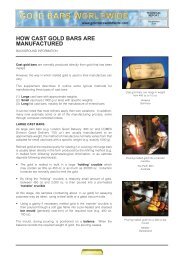Indian Gold Book:Indian Gold Book - Gold Bars Worldwide
Indian Gold Book:Indian Gold Book - Gold Bars Worldwide
Indian Gold Book:Indian Gold Book - Gold Bars Worldwide
You also want an ePaper? Increase the reach of your titles
YUMPU automatically turns print PDFs into web optimized ePapers that Google loves.
PRICING AND PROFITABILITY<br />
GOLD BULLION<br />
BANK IMPORTERS<br />
The <strong>Gold</strong> Cells of authorised bank importers are obliged to absorb all overheads and the direct costs incurred when buying<br />
gold bars (from international suppliers) and selling them (to secondary tier dealers). Overheads include administrative and<br />
insurance costs and, in some cases, the cost of consignment stocks that move slowly.<br />
To cover these costs, and to generate a profit, a <strong>Gold</strong> Cell generally relies on 3 - 5 sources of income.<br />
Small gross mark-up<br />
Banks normally apply a small percentage or rupee amount to the actual cost of the bullion (delivered to a location in India)<br />
at the time it is purchased from an international supplier.<br />
The actual cost takes into account the US dollar gold price quoted by the international supplier (that supplied the consignment<br />
stock), the bar mark-up per ounce charged by the supplier (inclusive of the refiner’s fabrication charge and the cost<br />
of insured delivery to the required city in India), the US$/rupee exchange rate, Customs duty, State sales taxes and other<br />
taxes.<br />
The bank’s gross mark-up on the actual cost of an imported TT bar is currently low, at around 0.1% (Rs 15 per oz - about<br />
US$ 0.32), although it can vary according to the size of the transaction and the prevailing level of TT supply and demand.<br />
Since the introduction of the OGL Scheme in 1997, the bank’s mark-up on imported TT bars has fallen significantly. In 1997,<br />
it was around 0.6% (about Rs 90 per oz - US$ 2).<br />
Rupee exchange rates<br />
The opportunity to convert US dollars into rupees in-house enables banks to generate a small amount of incremental income.<br />
Typically, a few paise per US dollar.<br />
Interest earned on advance payments<br />
As most secondary tier dealers are obliged to lodge large cash deposits and/or make payment in full before delivery, the<br />
bank can earn interest on those funds until obliged to pay international suppliers.<br />
Movements in the gold price<br />
Although the <strong>Gold</strong> Cells of most banks are permitted to take some risk on movements in the gold price, almost all do not.<br />
On rare occasions, in a rapidly rising gold price scenario and anticipated demand is “guaranteed”, a small risk might be<br />
undertaken by some.<br />
<strong>Gold</strong> loans<br />
Income is also derived if the bank offers gold loans to jewellery exporters (and, if it is part of the <strong>Gold</strong> Deposit Scheme, to<br />
domestic fabricators and retailers).<br />
For example, one bank requires a cash deposit (110%), a bank guarantee (110%) or other securities to 100% value of the<br />
gold plus 10% cash, plus an annualised interest payment ranging from 7.5% to 10.5%, plus handling charges.<br />
Addendum<br />
International refiners that supply TT bars indirectly (via international dealers) have seen their margins on TT bars fall<br />
substantially, from around US$ 1.25 - 1.50 per ounce in the early 1990s to less than 70 cents in 2002.<br />
BULLION DEALERS<br />
Secondary tier dealers<br />
The relatively few domestic dealers that buy TT bars in bulk from bank importers normally place an accumulated order on<br />
behalf of several subsidiary customers (e.g. lower tier dealers and large jewellery businesses) in order to eliminate or reduce<br />
their exposure to an unexpected fall in the rupee gold price. When acting on behalf of others, their margins tend to be<br />
small, usually less than Rs 50 per ounce. When buying on their own account, their profit or loss is dependent on<br />
movements in the standard bullion price.<br />
Lower tier dealers<br />
Tertiary and lower tier dealers may also reduce their risk by acting on behalf of others. However, in the absence of a<br />
hedging facility, both large and smaller dealers (and their customers) are exposed to unexpected falls in the gold price. Their<br />
profit or loss is dependent on movements in the standard bullion price, and sometimes the prevailing price of unofficial<br />
imports of TT bars.<br />
For this reason, most lower tier dealers (and their customers) tend to buy TT bars in small quantities, often on a daily basis.<br />
154<br />
AN INTRODUCTION TO THE INDIAN GOLD MARKET

















